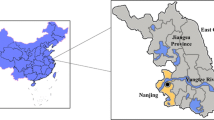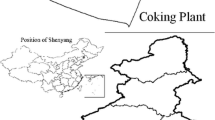Abstract
Application of Probabilistic Risk Assessment (PRA) and Deterministic Risk Assessment (DRA) at a coking plant site was compared. By DRA, Hazard Quotient (HQ) following exposure to Naphthalene (Nap) and Incremental Life Cancer Risk (ILCR) following exposure to Benzo(a)pyrene (Bap) were 1.87 and 2.12 × 10−4. PRA revealed valuable information regarding the possible distribution of risk, and risk estimates of DRA located at the 99.59th and 99.76th percentiles in the risk outputs of PRA, which indicated that DRA overestimated the risk. Cleanup levels corresponding acceptable HQ level of 1 and ILCR level of 10−6 were also calculated for both DRA and PRA. Nap and Bap cleanup levels were 192.85 and 0.14 mg·kg−1 by DRA, which would result in only 0.25% and 0.06% of the exposed population to have a risk higher than the acceptable risk, according to the outputs of PRA. The application of PRA on cleanup levels derivation would lift the cleanup levels 1.9 times for Nap and 2.4 times for Bap than which derived by DRA. For this coking plant site, the remediation scale and cost will be reduced in a large portion once the method of PRA is used. Sensitivity analysis was done by calculating the contribution to variance for each exposure parameter and it was found that contaminant concentration in the soil (C s), exposure duration (ED), total hours spent outdoor per day (ET out), soil ingestion rate (IR s), the air breathing rate (IR a) and bodyweight (BW) were the most important parameters for risk and cleanup levels calculations.
Similar content being viewed by others
References
Okx J P, Hordijk L, Stein A. Managing soil remediation problems. Environmental Science and Pollution Research, 1996, 3(4): 229–235
Blum WEH. European soil protection strategy. Journal of Soils and Sediments, 2003, 3(4): 242
Medical Research Council, Institute for Environment and Health, Risk Assessment and Toxicology Steering Committee. Risk Assessment Approaches Used by UK Government for Evaluating Human Health Effects of Chemicals. Institute for Environment and Health. Leicester: Institute for Environment and Health, 1999
Elliott P L. Use of Risk-Based Decision-Making in UST Corrective Action Programs. Washington, D C: Office of Solid Waste and Emergency Response, 1995
Viscusi WK, Hamilton J T, Dockins P C. Conservative versus mean risk assessments: implications for superfund policies. Journal of Environmental Economics and Management, 1997, 34(3): 187–206
US EPA. Assessment Guidance for Superfund Volume 1: Human Health Evaluation Mannual.Washington, D C: Office of Emergency and Remedial response, 1989
McKone T E. Alternative modeling approaches for contaminant fate in soils: uncertainty. Reliability Engineering & System Safety, 1996, 54(2–3): 165–181
Travis C C, Obenshain K R, Regens J L, Whipple C G. Limitations of multimedia models for use in environmental decision making. Environmental Monitoring and Assessment, 2001, 71(1): 51–60
US EPA. Risk Assessment Guidance for Superfund: Volume III-Part A. Washington D C, USA: Process for Conducting Probabilistic Risk Assessment, 2001
Lester R R, Green L C, Linkov I. Site-specific applications of probabilistic health risk assessment: review of the literature since 2000. Risk Analysis: An Official Publication of the Society for Risk Analysis, 2007, 27(3): 635–658
Öberg T, Bergbäck B. A review of probabilistic risk assessment of contaminated land. Journal of Soils and Sediments, 2005, 5(4): 213–224
Bogen K T, Cullen A C, Frey H C, Price P S. Probabilistic exposure analysis for chemical risk characterization. Toxicological Sciences: an official journal of the Society of Toxicology, 2009, 109(1): 4–17
Bonomo L, Caserini S, Pozzi C, Uguccioni D A. Target cleanup levels at the site of a former manufactured gas plant in Northern Italy: deterministic versus probabilistic results. Environmental Science & Technology, 2000, 34(18): 3843–3848
Beijing Municipal Environmental Protection Bureau. Environmental Site Assessment Guideline. Beijing: Beijing Bureau of Quality and Technical Supervision, 2009 (in Chinese)
US EPA. Method 8270D: Semivolatile Organic Compounds by Gas Chromatography/Mass Spectrometry (GC/MS). Virginia: National Technical Information Service, 2007
Environment Agency. CLEA Software (Version 1.05) Handbook. Bristol: Environmental Agency, 2009
Oregen Department of Environmental Quality. Guidance for Use of Probabilistic Analysis in Human Health Risk Assessments. Portland, Oregen: Oregen Department of Environmental Quality, 1999
California E P A. CalTOX, A Multimedia Total-Exposure Model for Hazardous-Waste Sites Part III: The Multiple Pathway Exposure Model Sacramento: Office of Scientific Affairs, Department of Toxic Substances Control, California Environmental Protection Agency, 1993
Jiang L, Jia X Y, Xia T X, Yao J J, Liang J, Wang Q. Research on application of PRA in health risk assessment of soil in a coking plant site. Research of Environmental Sciences, 2013, 26(2): 220–226 (in Chinese)
Avagliano S, Parrella L. Managing uncertainty in risk-based corrective action design: global sensitivity analysis of contaminant fate and exposure models used in the dose assessment. Environmental Modeling and Assessment, 2009, 14(1): 47–57
Kirman C, Budinsky R A, Yost L, Baker B F, Zabik JM, Rowlands J C, Long T F, Simon T. Derivation of soil clean-up levels for 2,3,7,8-tetrachloro-dibenzopdioxin (TCDD) toxicity equivalence (TEQD/F) in soil through deterministicand probabilistic risk assessment of exposure and toxicity. Human and Ecological Risk Assessment, 2011, 17(1): 125–158
US EPA. Risk Assessment Guidance for Superfund VolumeI: Human Health Evaluation Manual (Part E, Supplemental Guidance for Dermanl Risk Assessment). Washington, D C: Office of Superfund Remediation and Technology Innovation, 2004
US EPA. Assessing Dermal Exposure form Soil. Washington, D C: HazardWaste Management Division Office of Superfund Programs, 1995
BMEPB (Beijing Municipal Environmental Protection Bureau). Screening Levels for Soil Environmental Risk Assessment of Sites. Beijing: Beijing Bureau of Quality and Technical Supervision, 2011 (in Chinese)
Ma J, Zhou Y Z. Soil pollution by polycyclic aromatic hydrocarbons: A comparison of two Chinese cities. Journal of Environmental Sciences, 2011, 23(9): 1518–1523
Juhasz A L, Naidu R. Bioremediation of high molecular weight polycyclic aromatic hydrocarbons: a review of the microbial degradation of benzo[a]pyrene. International Biodeterioration and Biodegradation, 2000, 45(1–2): 57–88
Cullen A C. Measures of compounding conservatism in probabilistic risk assessment. Risk analysis: an official publication of the Society for Risk Analysis, 1994, 14(4): 389–393
Kuusisto S M, Tuhkanen T A. Probabilistic risk assessment of a contaminated site. In: International Conference on Practical Applications in Environmental Geotechnology Ecogeo 2000, Finland. Finland: Vammalan Kirjapaino Oy Press, 2001, 99–105
Sander P, Öberg T. Comparing deterministic and probabilistic risk assessments. A case study at a closed steel mill in southern Sweden. Journal of Soils and Sediments, 2006, 6(1): 55–61
Priha E, Hellman S, Sorvari J. PCB contamination from polysulphide sealants in residential areas—exposure and risk assessment. Chemosphere, 2005, 59(4): 537–543
Bruce E D, Abusalih A A, McDonald T J, Autenrieth R L. Comparing deterministic and probabilistic risk assessments for sites contaminated by polycyclic aromatic hydrocarbons (PAHs). Journal of Environmental Science and Health. Part A, Toxic/Hazardous substances & environmental engineering, 2007, 42(6): 697–706
Wenning R J. Uncertainties and data needs in risk assessment of three commercial polybrominated diphenyl ethers: probabilistic exposure analysis and comparison with European Commission results. Chemosphere, 2002, 46(5): 779–796
Jager T, Vermeire T G, Rikken M G J, van der Poel P. Opportunities for a probabilistic risk assessment of chemicals in the European Union. Chemosphere, 2001, 43(2): 257–264
Author information
Authors and Affiliations
Corresponding author
Rights and permissions
About this article
Cite this article
Xia, T., Jiang, L., Jia, X. et al. Application of probabilistic risk assessment at a coking plant site contaminated by polycyclic aromatic hydrocarbons. Front. Environ. Sci. Eng. 8, 441–450 (2014). https://doi.org/10.1007/s11783-013-0572-6
Received:
Accepted:
Published:
Issue Date:
DOI: https://doi.org/10.1007/s11783-013-0572-6




